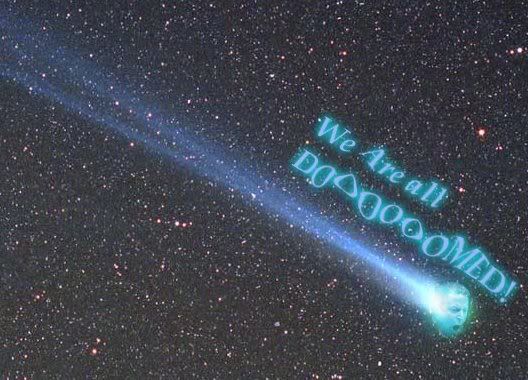
Posted on 12/31/2009 6:51:49 PM PST by neverdem
Love it.
Yes, in the ice cores, representing tens and hundreds of thousands of years, since the recent era of intermittent ice ages began, CO2 lags temperature changes. In the much longer time-scale measurements (hundreds of millions of years), there’s very little correlation. These time scales I alluded to aren’t much useful for showing which led which, but they demonstrate the idiocy of the notion that CO2 is proportional to atmospheric temperature.
CO2 absorbs in the infrared portion of the electromagnetic spectrum. That's suposed to translate into retained heat. I never heard or read anyhing more than that.
The various figures you mention assume there is no argument about their accuracy, nor for that matter the figures I mntioned. So perhaps the boloid events are closer to some other measured events.
You mention that glaciation in Antarctica started about 42 mya. Other comments refer to later figures, although those could refer to well developed glaciation, not the beginning. Interesting factoid: If you look at the sea mounts leading off from the Hawaii hot spot, you will see that at first they trend east north east, then there is a sharp movement more directly to the north. I believe the age given for this directional change was around 43 mya. So the question, if my memory and their figures are correct, did some major event start the Antarctic glaciacion?
I really hope that more interdisciplinary work will be done on identifying and dating all these different major events—boloid, volcanic, seismic, etc. Only then will it be possible to develop the most accurate theories and come to conclusions that most people will accept.
As a little boy I often tried to convince my mother otherwise.
I think what really happened with the Antarctic glaciation timeline is that:
1) Antarctica was already more-or-less over the South Pole as early as 60 million years ago and a few glaciers developed on the higher mountain ranges particularly about 42 million years ago; but,
2) It was also connected to South America and Australia at the time so that the ocean currents were mixed with mid-latitude/tropical ocean currents in gyres in the Pacific and the Atlantic/Indian Oceans which keep it reasonably warm - still frigid in the Winter but the snow and ice melted in the Summer.
3) About 34 million years ago, enough separation occured between South America and Australia, that the Antarctic Circumpolar Current developed which isolated Antarctica in an extreme polar climate.
4) It rapidly glaciated over after this.
5) About 27 million years ago, some jostling of the small cratons between South America and Antarctica closed off the Antarctic Circumpolar Current again and the glaciers melted back considerably.
6) About 14 million years ago, the Circumpolar Current was re-established and Antarctica glaciated over again.
7) About 2.5 million years ago, the Earth cooled off even more (due to events in the Arctic ocean which are still not explained other than Greenland and the Arctic Archipelago were slowly drifting north), and Antarctica glaciated over even more than previously more-or-less similar to today.
That is my timeline of events and I have spent a lot of time researching this. I could quote about 50 sources but I hate doing that.
Antarctica was also glaciated over between 330 to 290 million years ago, 430 to 420 million years ago and 640 to 600 million years ago when Continental Drift also placed it near the South Pole. It is the unlucky Continent.
So, you obviously grew up to be become an Earth Scientist? ;-)
Thank you for the detailed information. I have a special interest in boloid and volcanic influence on earth history.
Since you have put considerable effort into Antarctic study, I was wondering if you have any thoughts, feelings, conjectures on the apparent thawed state of parts of Antarctica that seem to be shown on the Piri Reis (sp?) map.
Well, there is some research pointing to a large ancient impact crater on Antarctica although it is covered in ice right now so we can’t be sure if it is a real impact or about its age.
http://en.wikipedia.org/wiki/Wilkes_Land_crater
The Reis map looks like a map of South America. The refence to hot conditions and snakes is probably the Amazon. One issue is the extremely strong west winds and storms that exist once one gets to the southern tip of South America. Year 1500 sailing ships would have been wise to turn back at that point.
The story I heard was that the Reis map might have been based on a much older possibly BC map made when Antarctica was less cold.
Nice link. My gosh, a 300 mile wide crater. The suggestion that it might not have anything to do with the great Permian extinction event because of the Bedout Crater off Australia does not make sense. If there is anything we should have learned from the Shoemaker-Levy meteor strikes on Jupiter a few years back, it is that boloid strikes can come in groups.
Regarding the Yucatan Crater that nixed the dinosaurs, have you heard about the Shiva Crater off India, and perhaps related to the Deccan Trapps. For that matter, how do we know that the Siberean Trapps that are of the end Permian age were not started by a boloid strike. So much to learn, I wish I were 40 years younger to see it all unfold.
Disclaimer: Opinions posted on Free Republic are those of the individual posters and do not necessarily represent the opinion of Free Republic or its management. All materials posted herein are protected by copyright law and the exemption for fair use of copyrighted works.